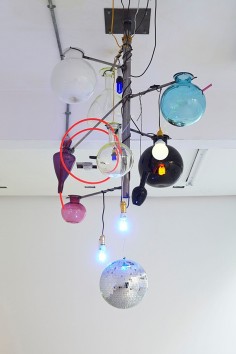Elias Hansen
You can cry all you want, but it ain’t changing shit
source: jonathanvinergallery
Elias Hansen
Born in 1979, lives and works in upstate New York.
“The pieces are fragments of story lines… I want to create a fantastical scene, one that takes you right to the edge of reality, but doesn’t let go of you. You are given just enough information to build your own storyline, but not so much you can’t follow it.”
Elias Hansen’s delicate blown-glass sculptures are presented alongside deteriorating found objects; neutralising the contradictory status of the precious to the discarded and evoking a dialog between the histories of each object. Juxtapositioning the worn and the exquisite, Hansen’s elaborate structures resemble an ultimately dysfunctional meth lab, translating the idealism and escapism of the industry into a compelling visual language tinged with the secrecy and mystery.
.
.
.
.
.
.
.
source: artinamericamagazine
Elias Hansen is a 21st-century Morandi of the backwoods—a ponderer and scavenger whose meditations on a limited array of objects read as a sort of private poetry. Neither a recluse nor an outsider, he is a schooled, sophisticated maker forging a union between skilled and de-skilled practices. His predilections run toward both the raw and the refined.
Hansen’s work typically takes the form of casual-looking assemblages on wall-mounted, unpainted wooden shelves. The vessels of chemistry labs and distilleries prevail: flasks, beakers and pipettes, hand-blown mostly by Hansen in gem and candy colors, including emerald, ruby, grape and tangerine. Some resemble bongs, others bulbous gourds. Interspersed among them are rustic objects—old doorknobs, keys, a rusted railroad spike, a worn bristle brush-found near the artist’s home in the Hudson Valley, where he moved a few years ago from the Pacific Northwest.
Cheap plastic items and trippy decor, such as rotating spheres of colored, strobing lights, provide a stark contrast to the antique patinas of oxidized coins and cloudy glass bottles. Capping off most of these disparate assemblies are single, bare-coil lightbulbs of lurid green or pulsing purple, hanging from cords looped around nails in the wall.
In It’s a pretty straight shot (2013), Hansen presents a sequence of objects on a trapezoidal shelf. From left to right, in a progression of forms that moves, vaguely, from the more recent to the more historical and then ends with the timeless, stand a large brown beer bottle, a slender glass flask, a small Roman-looking bottle and finally a seashell. On the triangular shelf of Not that I can remember (2014) rest a scattering of old coins, a broken glass test tube, a ruby vase and an old flask, the last two items corked. A vase of swirled fuchsia dangles from a wire off the side of the shelf.
Hansen’s titles sound like statements extracted midstream from conversations, and frequently refer to navigational positioning: You’ll see it at the bottom of the hill; This is where the trail used to be; and I’m a long way from home and I don’t really know these roads. The relationships between the objects feel contingent, a matter of continual exploration rather than fixed, predetermined meaning. The intervals between things too often feel uniform, however, and the rhythms static.
Hansen’s direction in this new work seems uncertain. The pieces are dense with the metaphors of creation—brewing, concocting, alchemizing—seen in his earlier efforts, but largely lack the meth-and-moonshine vibe of their predecessors (which, for instance, feature groups of objects on rough tree limbs rather than on smooth planes of lumber). Fewer dark secrets lurk here. Instead of a charmingly deviant chemist, these pieces conjure an earnest tinkerer with a mellow sense of humor. Where they resonate with consistent strength is in their evocation of dual, complementary sources of wonder: the material present, the here, and the chemically accessed elsewhere, the out there.


